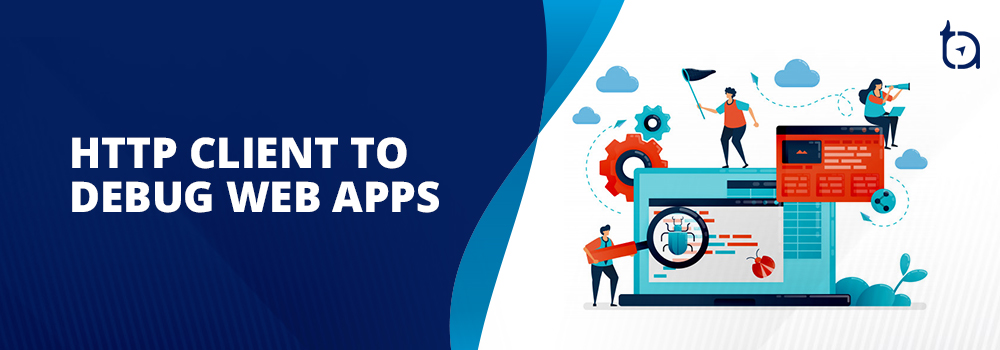Debug Web Applications With HTTP Client

Author : Abishek Surya RS 14th May 2020

Debugging web apps is one of the core skills of any developer. It is essential to be able to fix the errors in web applications and APIAPIAn application program interface (API) is a set of routines, protocols, and tools for building software applications. Basically, an API specifies how software components should interact. Additionally, APIs are used when programming graphical user interface (GUI) components. services. For this reason, you need to have a good understanding of the HTTPHTTPHTTP means HyperText Transfer Protocol. HTTP is the underlying protocol used by the World Wide Web and this protocol defines how messages are formatted and transmitted, and what actions Web servers and browsers should take in response to various commands. Client and HTTP Server. By knowing the right tools, you can debug web applications to a great extent using HTTP Client.
What is Debugging?
Debugging is the process of finding out and then fixing errors within a program. It also fixes all the issues that hinder the flow and stop the smooth running of a software program. For a web application, the first step in debugging is reproducing the issue. Next, you need to send out API requests. This causes problems since you need to do some HTTP manipulations and most browsers prevent you from doing so.
This requires the help of effective debugging tools. Some of the components of a powerful debugging process, such as interactive debugging, unit testing, integration testing, etc. Some web browsers have their in-built developer tools that you can use to debug APIs. So, it becomes unnecessary to write your debugging tool.
What is HTTP Client?
HTTP Client is any device that sends requests to a server in HTTP format and receives a response from the same server. HTTP is an application protocol that sends rules on how to communicate over the web. If you are looking to communicate through the internet, the most common medium of communication is the HTTP, HyperText Transfer Protocol. Using this distributed means of communication, you can connect and transfer data using the web.
Difference between HTTP Client and Server
HTTP Clients are often web browsers, and HTTP Servers are often proxies to application servers. The relationship between the HTTP client and server is a conversational one, where the HTTP client sends a request to the server, and the server responds.
For example, your smartphone may be connected to the internet using an HTML client, and the HTML server may act as proxies to the application server. They serve as HTMLHTMLHypertext Markup Language is the standard markup language for documents designed to be displayed in a web browser. It can be assisted by technologies such as Cascading Style Sheets and scripting languages such as JavaScript., CSSCSSCascading Style Sheets is a style sheet language used for describing the presentation of a document written in a markup language like HTML. CSS is a cornerstone technology of the World Wide Web, alongside HTML and JavaScript., PythonPythonWith dynamic semantics, Python is an object-oriented, interpreted, high-level programming language. Python reduces the maintenance cost of the program as it has simple and easy to learn syntax that emphasizes readability. Thanks to its high-level built-in data structures for making it attractive for Rapid Application Development, as well as for using it as a scripting language. Python supports a wide range of libraries and a few of them are numpy, pandas, matpotlib, scipy, etc., among others.
Debugging APIs using HTTP Clients can be done in two ways.
- Using Command-line HTTP Client
- Using Web Browsers
Debugging with Command-line HTTP Client
- HTTPie
HTTPie is a command-line HTTP client. Its goal is to make command-line interface interaction with web services as user friendly as possible. It offers a simple HTTP command to send HTTP requests using a natural syntax. HTTPie can normally be used for testing, debugging, and interacting with HTTP servers.
Best Features
- It has an expressive and intuitive syntax
- Formatted and colorized terminal output
- Built-in JSON Support
- Supports HTTPS, Proxies, and Authentication.
- Provides Linux, macOS and Windows Support
- Supports Customs Headers.
- You can send an arbitrary custom data request
- Supports Python 2.7 and 3.x
- Forms and File Uploads
- Documented
- Requester
The requester is a command-line client that captures and combines the features of three other command-line clients, namely HTTPie, Postman, and Paw. It has been configured to work only with Sublime Text Editor. It is built for speed and simplicity. It is cross-platform and built for teams.
Best Features
- Support for JSON schema
- Requests Collections and History.
- Colorized output with automatic syntax highlighting.
- Full GraphQL support
- Forms and file uploads.
- Customizable headers.
- Export requests to cURL and HTTPie, import requests from cURL
- AB-style benchmarking tool
- Runs on Linux, macOS, and Windows.
- Clear error handling and error messages.
- RESTer
It is available as an extension for Firefox and Google Chrome.
Main Features
- Authorization headers with Basic or Auth2 authentication.
- View request history.
- Perform requests with any method, URL, body, and custom header
- Test and Debug APIs
- Paw
Paw is an HTTP client that allows you to send the APIs. It has a native macOS interface that lets you test APIs and deploys new ones. There are the free trial version and the paid version at $49.99 with a forever license with one user on up to three machines at a time.
Main Features
- Exclusively built for the macOS.
- Fully featured Visual Editor and HTTP toolset.
- Supports JSON schema
- Fully compliant with Swagger and RAML descriptions.
- Built for teams and as powerful as Git for version control.
- Postman
Postman is one of the most popular HTTP clients for debugging web applications. It is also a collaboration platform for API development.
Main Features
- It has a powerful graphical user interface.
- History of requests.
- Detailed API documentation.
- Full GraphQL support within Postman.
- Flexible API monitoring.
- Supports Automated testing with Collection runner.
- Supports split-stack development
- Supports a variety of payloads including JSON and HTML
- NetTool
NetTool is a free network and web debugging tool. It has been designed with a special emphasis on web apps and web services. Unlike the other tools, it has two components, the TCP tunnel, and the HTTP client. It can be used to monitor a web application’s accuracy, performance, and uptime. It can also be used to manipulate an application’s network messages.
Main Features
- Provides support to commonly used network protocols.
- Performs SSH certification verification.
- Included in nix distribution
- Supports building and deploying scripts in testing and deployment environments.
- Fiddler
Fiddler is a cross-platform web application debugging proxy which you can use to manipulate web sessions. It can decrypt HTTPS traffic and display web application requests. With Fiddler, you can create and customize your HTTP requests. Furthermore, the cookies, headers, and cache directives are transferred between client and server.
Main Features
- Web session manipulation
- Security testing
- Web debugging
- Performance testing
- HTTP/ HTTPS traffic recording
- Customization facility
- Charles Proxy
Charles proxy again is one of the most popular debugging tools. It is an HTTP proxy and works by routing local machine traffic through it. It can work on any smart device, any OS, and PC if you get it properly configured. It can be used for SSLSSLSSL (Secure Sockets Layer) is a standard technology behind establishing an encrypted connection between a web server (host) and a web browser (client). proxying, AjaxAjaxAjax is a set of web development techniques using many web technologies on the client-side to create asynchronous web applications. With Ajax, web applications can send and retrieve data from a server asynchronously without interfering with the display and behavior of the existing page. debugging, breakpoints, etc.
Debugging with Web Browsers
- Firefox
Though Internet Explorer is not effective in dealing with severe web API related development issues, it can be used to check for crash reports. It is also useful in checking for error and defective codes.
- Internet Explorer
Though Internet Explorer is not effective in dealing with severe web API related development issues, it can be used to check for crash reports. It is also useful in checking for error and defective codes.
- Safari
The web developer tool by Apple Safari comes with a web inspector tool. This makes the process of debugging a web application so much simpler. It has an interface with a Responsive Design to view web pages, their orientation, and resolution.
- Chrome
Chrome developer tools are built directly in the browser and allow you to edit pages very quickly. You can inspect APIs in no time, and this reduces stress significantly.
Conclusion
The process of debugging web applications is not an easy one and needs a certain level of expertise and skill. These HTTP client tools need to be used well to solve the issues in the right way.
At TechAffinity, our team of experts is skilled in delivering web development services that are tailored to meet the needs of your business. In case of any queries, feel free to send them to media@techaffinity.com or schedule a meeting with our team.
